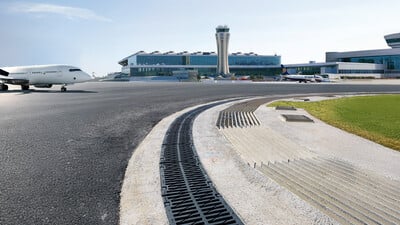Airports and dockyards rely on robust drainage systems to manage surface water efficiently. With their vast expanses of non-porous concrete and asphalt, airports and dockyards are highly susceptible to water accumulation, leading to disruption and safety risks.
Flooding and standing water can create serious hazards, from aquaplaning on runways to structural damage caused by water infiltration. In freezing conditions, untreated water can form ice, increasing the risk of accidents and interfering with the fast-paced operational efficiency of airports and dockyards, where small minutes cost big money. Properly designed channel drainage prevents these issues, enhancing safety and prolonging the lifespan of paved surfaces.
How Channel Drains Work
Unlike traditional gully drains that collect water at a single point, channel drains feature a long, linear design that captures surface water continuously along their length. This design ensures faster drainage, reducing the risk of standing water and ice formation. Installed flush with the ground, they direct water into underground drainage systems, soakaways or treatment units, depending on the site’s requirements.
Materials Used in Channel Drains
The materials used for channel drains vary based on application and load requirements. For high-traffic areas such as airports and dockyards, durability and strength are key considerations:
Ductile Iron
Commonly used for gratings and sometimes for the channel body itself, ductile iron provides exceptional strength, impact resistance, and durability under heavy traffic loads.
Polymer Concrete
A composite material made from resin and mineral aggregates, polymer concrete is highly resistant to chemical exposure, water absorption and freeze-thaw cycles.
Reinforced Concrete
Traditional concrete with added steel reinforcement is sometimes used for the channel body in ultra-heavy-duty applications, providing excellent load-bearing capacity.
Stainless Steel
Less common for entire drain bodies but used in certain high-corrosion environments like marine docks or chemical plants, stainless steel offers excellent resistance to rust and chemical exposure.
In addition, galvanised or stainless steel edge rails are often integrated into polymer concrete or concrete channels to enhance durability and prevent damage from heavy loads.
Load Ratings for Heavy-Duty Applications
Given the immense loads exerted by aircraft, cargo trucks and heavy machinery, selecting the appropriate load rating is critical. Channel drains are classified under BS EN 124:2015 standards, with the following ratings relevant to airports and dockyards:
E600 (60 tonnes)
A heavy-duty channel drain that is commonly used in industrial zones with forklifts and material handling equipment.
F900 (90 tonnes)
This highest-rated channel drain should be used for aircraft runways, aprons and dockyards where extreme loads are common.
For effective water management in high-traffic areas, investing in a properly designed channel drainage system is essential. To explore high-performance drainage solutions for airports and dockyards, get in touch with our team today – call 01420 555600 or email [email protected].

Written by
Bob Stone
Technical Sales
Heading up our Technical Estimating Department, Bob is our in-house quantity surveyor.

